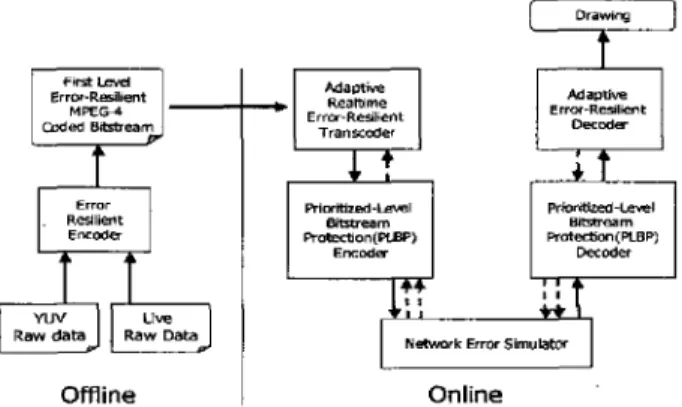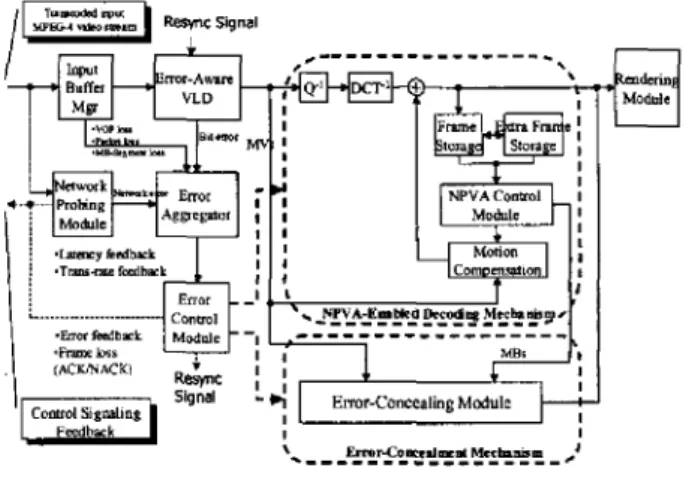7.2-5
Error-Resilient
MPEG-4 Video Communication over Error-Prone Wireless Networks
Tu-Chun Yin,
Yi-Chin Huang, Meng-Hui Lin, Wen-Chin Chen
Communication
and
Multimedia Lab.,
Department
of
Computer Science
and
lnformation Engineering,
National Taiwan University,
Taipei, Taiwan
E-Mail:
{birding,
yichin,
d i n , wcchenJ@cmlab.csie.ntu.edu.
hv
ABSTRACT
This paper presents an error-resilient MPEG-4 video communication system. The system comprises an error-resilient encoder, an adaptive error-resilient transcoder, an error-resilient decoder and the PLBP encoderidecoder. It has been evaluated under a configurable network error simulator. In addition, the system integrates the error resilience tools defined in MPEG-4 visual standard, namely Video Packet Structure, Header Extension Code (HEC) and NEWPRED, as well as three proposed novel error-resilient techniques, namely Prioritized- Level Bitstream Protection
(PLBP),
Protected Data Partitioning (PDP) and Restorative Intra Adoption (RIA). In the decoder, three error concealment techniques are implemented. They are temporal replacement, motion replacement, and predictive motion replacement. The decoder also implements anerror
detection mechanism that has high sensitivity to catch errors. Finally, the performance of the hybrid error-resilient system has been evaluated. The experimental results show that under the error-prone networks, acceptable video quality has been successfully retained without incurring much overhead.
1.
INTRODUCTION
Wireless multimedia services will soon become a reality due to the advancement of telecommunication infrastructure, such as GPRS and 3G networks, and the improvement o f network transmission
quality.
However, although technologies of wireless networks are getting much maturer, theessence
of wireless networks does not change. Shading and multi-path effects of electromagnetic wave cause random and burst errors. Above network layer, applications still has to afford high end-to-end delay, packet loss, random and burst residual error, which cannot be resolved by channel coder below network layer. On the other hand, bandwidth is a scarce resource of wireless channel. Thus, low-bitrate transmission becomes an important issue for wireless applications. Therefore, video communication over erroneous wireless channel requires the support of low bitrate and error- resilient capability. In this circumstance, MPEG-4 is an appropriate video coding scheme.However, due to the vulnerability of the MPEG-4 video coding algorithms, two cases should he considered when a coded bitstream is hit by errors. In the first case, when an error is detected, the decoder bas to discard all bits until next resynchronization point arrives.
Lots
of information is desolated and visual quality is seriously damaged. For the other case, bits need not to be discarded. However, the decoder may get incorrect values and the visual quality is somewhat inevitably decreased.Due to the features of MPEG-4 coding algorithms, the influence caused by any incorrectly decoded value or impairment
of visual quality probably be propagated to other parts of the same VOP (spatial error propagation) or other VOPs (temporal error propagation). Consequently, to retain visual quality in erroneous circumstance, a video communication system has to reduce the range of the spatial error effect and
stop
the temporal error propagation.2.
A Hybrid and Adaptive
Error Resilient System
As shown in figure I , the system
consists
ofsix
modules, including Encoder, Network Error Simulator, PLBP EncoderiDecoder, Transcoderand
Decoder.I I I
Offline
I
OnlineFigure 1. System Functional Block Overview Encoder
Besides normal encoding functionalities, the encoder encodes motion areas in intra mode more frequently by adopting Adaptive Intra Refresh (AIR) mechanism. In a video presentation, human eyes tend to focus on high motion area. However, high motion area usually generates more bits than still area does. This implies high motion areas are more likely hit by error. Moreover, temporal predictive coding technique aggravates error propagation for high motion area. To
solve
the problem, AIR is adopted to help the decoder recover the corrupted motion area quickly and stop the error propagation. Motion analysis module and intra refresh decision module shall additionally be implementedin
the encoder.PLBP
EncodedDecoderIn
order to prevent MPEG-4 bitstream from being destroyed by residual error,PLBP
provides application-layer channel coding. The higher level of protection applying on data brings more channel-coding overhead. Thus, there exists a tradeoff between the level of protection and channel-coding overhead. On the other hand, it is observed that data which are more important are usually smaller. Thus, applying the samelevel of protection on the entire bitstream is not an efficient way.
PLBP
ensures
different sectionsof
abitstream
of
different importance are protected by different channel coding algorithms with different data protection capability. As a whole, the bitstream gets optimal protection ‘without incurring much overhead.Transcoder
According to feedback messages from the decoder, the transcoder adaptively transcodes coded MPEG-4 bitstream in a real-time manner. Four error-resilient techniques are integrated, namely Video Packet Structure (VPS), Header Extension Code
(HEC),
Protected Data Partitioning (PDP) and New Predictive VOP Adoption (NPVA). NPVA comprises NEWPRED and Restorative Intra Adoption (RIA).VPS reduces
the
range of spatial error propagation. Whenever the decoder loses synchronization with the bitstream due to some fatal decoding errors in one video packet (VP), it is able to resynchronize by the next VP in the same VOP. In order to realize resynchronization, spatial predictions of all macroblocks in a VP are bounded within the VP’s boundary. In addition, macroblocks in a VP can only make temporal reference to the VP that is at the same location in the predicted VOP. Predictions outside a VP boundary shall be altered.HEC makes each VP be decoded independently even without the information provided by the VOP header. If the VOP header is corrupted by the transmission error, its information can be recovered by HEC.
PDP separates the motion and macroblock header information away to form the texture information. Motion information, which is smaller but more important than texture information, gets a higher-level protection under the operation of PLBP mechanism. If the texture information is lost, the decoder can conceal these
errors
by utilizing the motion information.Errors introduced during transmission will lead to frame-
store mismatch between the transcoder and ihe decoder. NPVA helps the decoder
to
recover from temporal error propagations. It uses feedback messages to indicate which VP is erroneously decoded. In the transcoder, two transcoding strategies, namely Restorative Intra Adoption (RIA) and NEWPFED, will be applied altematively for each macroblocks that originally takes the lost video packet for temporal prediction. If a macroblock belongs to a portion of a high-motion area, RIA operates and the macroblock willbe
transcodedas
intra-mode. Otherwise, NEWPRED operates and the transcoder re-encodes the macroblock by utilizing latest correctly decoded video packet at the same place of previous VOP for temporal prediction.In
short, NPVA prevents temporal error propagation without inserting intra coded macroblocks and improves the visual quality in erroneous circumstances.Decoder
As shown in Figure 2, the decoder implements
an
error detection mechanism that has high sensitivity to catch errors. When some error is detected, the decoder sends a message back to server.In
addition,a
lost area can be concealed by one of the following error concealment techniques, namely temporal replacement, motion replacement, and predictive motion replacement. The first one simply copies pels from the previous VOP. When the motion information is correctly decoded, the second scheme is utilized to conceal the error. If correct motion information is not available, the final technique utilizes the knowledge about spatial correlation to predict the most-likely motion information.a
Module:*I
I
Error-ConcealinpModuleI
Figure 2. Architecture o f Decoder
Simulation Results
Network error simulator generates the residual error that cannot be resolved in network layer. Three types of error are supported: packet loss, random error, and burst error. With appropriate configuration set on the network error simulator, performance of various error-resilient techniques can be evaluated over the simulated wireless channel.
3. EXPERIMENTAL RESULTS AND CONCLUSIONS
Figure 3. The PSNR resuIts of “football.” (I) The uppermost line: error-free (2) the middle line: the enor-resilient system (3) the third
line: non-resilient and error-prone
The performance of the develop4 error resilient system was evaluated in the experiment. The test sequence “football” chosen for the simulation was encoded, transcoded and decoded in compliance with the MPEG-4 standard. The frame resolution, frame number, frame rate and
bit
rate were set to 352x288, 125 frames, 10 f p s and 384 kbitds. The performance is tested through the network error simulator. BER and average error length of the error pattern was set to 1 . 3 5 ~ 1 0 - ~ and 1.822 bits. Figure 3 presents the PSNR results of each kame. This result shows that in the best case, the error-resilient system improves PSNR from15 dB to nearly 30dB in average. Thus, the proposed system indeed retained acceptable video quality over error-prone wireless networks.
4.
REFERENCES
ISO/IEC 14496-2:2001(E), Part 2: Visual, “Information technology- Coding of audio visual objects”
Ming-Ting Sun, Amy R. Reibman, “Compressed Video over
Networks”. Marcel Dekker, Inc

